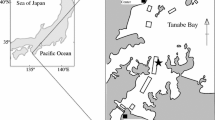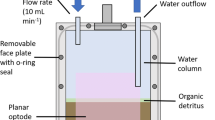Abstract
The contribution of bacteria to phosphorus (P) and nitrogen (N ) release from, or retention in, sediment was studied in a flow-through system. “Live” and formaldehyde-“killed” sediment communities were incubated in 25-liter bottles with a continuous flow of P- or P + N-enriched water. Sediment bacteria in the killed communities were inhibited by adding formaldehyde (final concentration 0.04% v/v) to the sediment before the start of the experiment. Bacterial activity in the live sediments measured with [3H]thymidine and [14C]leucine incorporation techniques did not change essentially during the experiment period (7–8 days). Chemical mechanisms were found to be of principal importance in PO4-P retention in the sediment. In the live samples, the net retention of PO4-P was lower than in the killed samples, which was likely due to the reduced O2 conditions in the sediment as a consequence of bacterial mineralization. In total P exchange, however, bacteria increased the retention rate by recycling dissolved organic P in the sediment. In the live communities the retention of N was very efficient, and all the introduced NH4 -N and NO3-N was immobilized by sediment bacteria. Nitrogen enrichment, however, did not alter the P exchange rates. The gradual emergence of bacterial activity (and grazing) in the killed communities, subsequent to the dilution of formaldehyde concentration, enhanced the release of PO4-P and NH4-N from sediment.
Similar content being viewed by others
References
Bates MH, Neafus NJE (1980) Phosphorus release from sediments from Lake Carl Blackwell, Oklahoma. Water Res 14:1477–1481
Bergström I, Heinänen A, Salonen, K (1986) Comparison of acridine orange, acriflavine, and bisbenzimide stains for enumeration of bacteria in clear and humic waters. Appl Environ Microbiol 51:664–667
Bloem J, Starink M, Bär-Gilissen M-JB, Cappenberg TE (1988) Protozoan grazing, bacterial activity, and mineralization in two-stage continuous cultures. Appl Environ Microbiol 54:3113–3121
Boström B, Jansson M, Forsberg C (1982) Phosphorus release from lake sediments. Arch Hydrobiol Beih 18:5–59
Forsberg C (1989) Importance of sediments in understanding nutrient cyclings in lakes. Hydrobiologia 176/177:263–277
Fuhrman J, Azam F (1982) Thymidine incorporation as a measure of bacterioplankton production in marine surface waters: evaluation and field results. Mar Biol 66:109–120
Gächter R, Meyer JS (1993) The role of microorganisms in mobilization and fixation of phosphorus in sediments. Hydrobiologia 253:103–121
Gächter R, Meyer JS, Mares A (1988) Contribution of bacteria to release and fixation of phosphorus in lake sediments. Limnol Oceanogr 33:1542–1558
Goldman JC, Caron DA, Dennett MR (1987) Regulation of gross growth efficiency and ammonium regeneration in bacteria by substrate C:N ratio. Limnol Oceanogr 32:1239–1252
Horppila J, Kairesalo T, Keto J, Peltonen H (1994) Linked decrease in the abundance and growth of roach (Rutilus rutilus (L)) and blue-green algae in Lake Vesijärvi (southern Finland) caused by intensive trawling. (submitted)
Hupfer M, Uhlmann D (1991) Microbially mediated phosphorus exchange across the mud-water interface. Verh Internat Verein Limnol 24:2999–3003
Jansson M (1987) Anaerobic dissolution of iron-phosphorus complexes in sediment due to the activity of nitrate-reducing bacteria. Microb Ecol 14:81–89
Jones JG (1979) Microbial nitrate reduction in freshwater sediments. J Gen Microbiol 115:27–35
Kairesalo T, Saukkonen P (1990) Thymidine incorporation by littoral and pelagial bacterioplankton in a mesohumic lake. Verh Internat Verein Limnol 24:677–681
Keto J (1982) The recovery of L. Vesijärvi following sewage diversion. Hydrobiologia 86:195–199
Keto J, Sammalkorpi I (1988) A fading recovery: a conceptual model for Lake Vesijärvi management and research. Aqua Fennica 18:193–204
Kirchman D, K'nees E, Hodson R (1985) Leucine incorporation and its potential as a measure of protein synthesis by bacteria in natural aquatic systems. Appl Environ Microbiol 49:599–607
Littell RC (1989) Statistical analysis of experiments with repeated measurements. HortScience 24:37–40
Liukkonen M, Kairesalo T, Keto J (1993) Eutrophication and recovery of Lake Vesijärvi (South Finland): diatom frustules in varved sediments over a 30-year period. Hydrobiologia 269/270: 415–426
Maxwell SE, Delaney HD (1990) Designing experiments and analyzing data. A model comparison perspective. Wadsworth Publishing, Belmont, Calif.
Moriarty DJW (1990) Techniques for estimating bacterial growth rates and production of biomass in aquatic environments. In: Grigorova R, Norris JK (eds) Methods in Microbiology, vol 22. Academic Press, London, pp 211–234
Murphy J, Riley JP (1962) A modified single-solution method for the determination of phosphate in natural waters. Analyt Chim Acta 27:31–36
Olsen SR, Sommers LE (1982) Phosphorus. In: Page AL, Miller RH, Keeney DR (eds) Methods of soil analysis. Part 2. Chemical and microbiological properties, 2nd ed. American Society of Agronomy and Soil Science Society of America, Madison, Wisc., pp 403–440
Pollard PC (1987) Dialysis: a simple method of separating labelled bacterial DNA and tritiated thymidine from aquatic sediments. J Microbiol Methods 7:91–101
Potvin C, Lechowicz MJ, Tardif S (1990) The statistical analysis of ecophysiological response curves obtained from experiments involving repeated measures. Ecology 71:1389–1400
Ryding S-O (1985) Chemical and microbiological processes as regulators of the exchange of substances between sediments and water in shallow eutrophic lakes. Int Revue Hydrobiol 70:657–702
Salonen K (1979) A versatile method for the rapid and accurate determination of carbon by high temperature combustion. Limnol Oceanogr 24:177–183
Salonen K (1981) Rapid and precise determination of total inorganic carbon and some gases in aqueous solutions. Water Res 15:403–406
SAS Institute Inc (1985) SAS users guide: statistics, version 5 edition. SAS Institute Inc, Cary, NC
SFS 3040 (1990) Determination of dissolved oxygen content in water, titrimetric method. The Finnish standard (in Finnish). Suomen Standardisoimisliitto, Helsinki
Simon M, Azam F (1989) Protein content and protein synthesis rates of planktonic marine bacteria. Mar Ecol Prog Ser 51:201–213
Sinke AJC, Cappenberg TE (1988) Influence of bacterial processes on the phosphorus release from sediments in the eutrophic Loosdrecht Lakes, The Netherlands. Arch Hydrobiol Beih Ergebn Limnol 30:5–13
Sinke AJC, Cottaar FHM, Keizer P (1993) A method to determine the contribution of bacteria to phosphate uptake by aerobic freshwater sediment. Limnol Oceanogr 38:1081–1087
Solorzano L (1969) Determination of ammonia in natural waters by the phenolhypochlorite method. Limnol Oceanogr 14:799–801
Tezuka Y (1990) Bacterial regeneration of ammonium and phosphate as affected by the carbon:nitrogen:phosphorus ratio of organic substrates. Microb Ecol 19:227–238
Tuominen L, Kairesalo T (1992) A method for measuring the uptake of thymidine and leucine in sediment. Aqua Fennica 22:43–48
Tuominen L, Kairesalo T, Hartikainen H (1994) Comparison of methods for inhibiting bacterial activity in sediment. Appl Environ Microbiol 60:3454–3457
van Duyl FC, van Raaphorst W, Kop AJ (1993) Benthic bacterial production and nutrient sediment-water exchange in sandy North Sea sediments. Mar Ecol Prog Ser 100:85–95
Walters K, Moriarty DJW (1993) The effects of complex trophic interactions on a marine microbenthic community. Ecology 74:1475–1489
Wood ED, Amstrong FAJ, Richards FA (1967) Determination of nitrate in sea water by cadmium-copper reduction to nitrite. J Mar Biol Assoc UK 47:23–31
Author information
Authors and Affiliations
Rights and permissions
About this article
Cite this article
Kairesalo, T., Tuominen, L., Hartikainen, H. et al. The role of bacteria in the nutrient exchange between sediment and water in a flow-through system. Microb Ecol 29, 129–144 (1995). https://doi.org/10.1007/BF00167160
Received:
Revised:
Issue Date:
DOI: https://doi.org/10.1007/BF00167160




